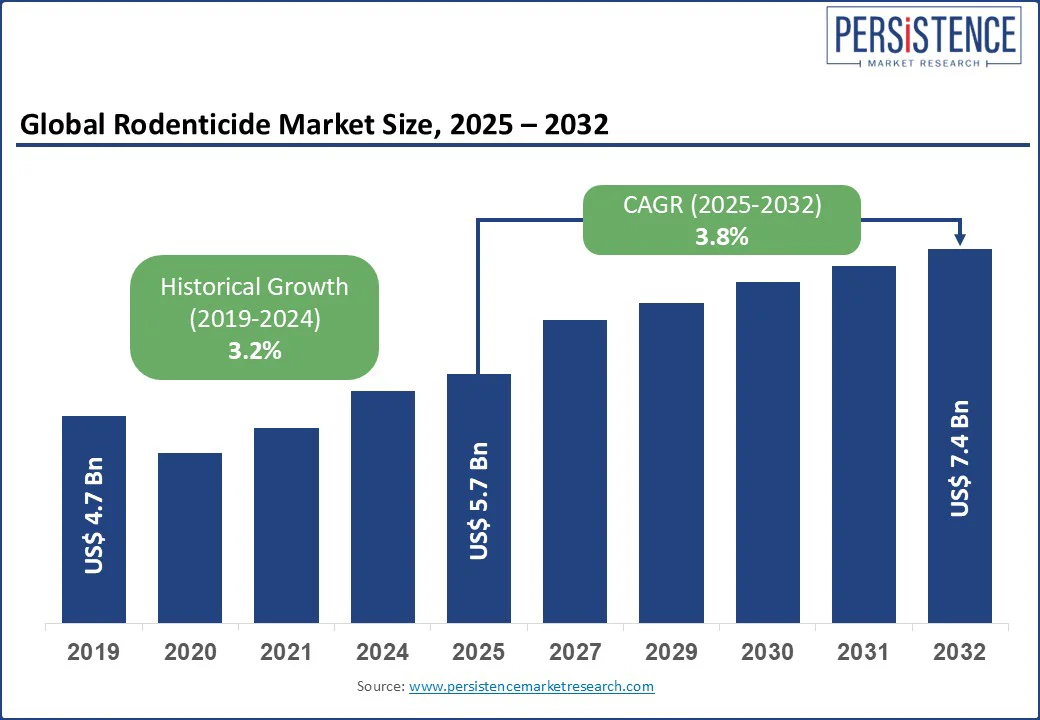ID: PMRREP3415| 173 Pages | 4 Aug 2025 | Format: PDF, Excel, PPT* | Chemicals and Materials

The global Rodenticide Market is likely to be valued at US$ 5.7 Bn in 2025 and reach US$ 7.4 Bn by 2032, achieving a CAGR of 3.8% from 2025 to 2032. This growth is fueled by increasing rodent populations, rising demand for pest management solutions, and advancements in rodenticide formulations.
The global rodenticide market is a critical component of the pest control industry, driven by the ongoing need to manage rodent infestations that threaten agriculture, urban centers, and public health. The sector’s expansion is supported by innovations in anticoagulant and non-anticoagulant rodenticides, growing awareness of rodent-related health risks, and increasing demand for effective rodent control in agricultural and urban settings. Rodenticides, available in forms such as pellets, blocks, and powder, are essential for mitigating crop losses, protecting stored goods, and preventing disease transmission.
North America leads the rodenticide market, followed by Europe and the rapidly expanding Asia Pacific, propelled by robust agricultural sectors, urbanization, and supportive regulatory frameworks. The industry is highly competitive, with key players focusing on eco-friendly formulations and strategic partnerships to enhance pest management solutions.

The technology’s unique capabilities and expanding applications are boosting the market. The rodenticide market is experiencing robust growth driven by the technology’s exceptional capabilities in addressing rodent infestations that cause significant economic and health impacts. Rodenticides are critical for rodent population control, as they prevent damage to crops, contamination of food, and the spread of rodent-borne diseases such as Hantavirus and plague. For instance, the CDC advises controlling rodent populations to reduce transmission of plague, as infected fleas may seek new hosts if rodents are eliminated improperly. Their use is expanding in agriculture, pest control, warehouses, urban centers, and households. As industries pursue food security and public health, rodenticides offer significant advantages over traditional anti-rodent solutions. Continuous R&D enhances formulation safety and efficacy, reinforcing their role in integrated pest management (IPM) strategies.
Rising agricultural and urban demands fuel rodenticide adoption.
Rodenticides play a vital role in safeguarding global food security and urban infrastructure. In agricultural settings, rodents are responsible for 5-10% of crop losses annually in Asia, highlighting the urgent need for effective pest control to protect yields. Simultaneously, rapid urbanization over 50% of the global population now residing in urban areas, according to the World Bank, intensifying the demand for rodent control in cities, where infrastructure and hygiene are at risk. This dual pressure from agricultural and urban sectors is driving the rodenticide market forward, with growing interest in advanced, non-toxic, and environmentally safe rodent control solutions to meet evolving regulatory and safety standards.
Among form types, pellets lead due to their ease of use, controlled release, and versatility in bait stations for agricultural and urban applications. In 2025, pellets accounted for a 45% market share. Blocks are the fastest-growing form, driven by their durability and suitability for outdoor environments, due to increased adoption in warehouses and urban centers.
Among product types, anticoagulant rodenticides lead due to their high efficacy, single-feed lethality, and widespread use in agriculture and pest control. In 2025, this segment held a Substantial market share by volume, driven by formulations such as bromadiolone and brodifacoum. Non-anticoagulant rodenticides, such as bromethalin and zinc phosphide, are the fastest-growing, fueled by demand for fast-acting solutions and regulatory restrictions on anticoagulants in regions such as North America and Europe.
Among application types, agriculture leads due to its critical role in protecting crops and stored grains, holding a 60% market share in 2025. Pest control companies are the fastest-growing segment, driven by the increasing outsourcing of rodent management in urban and commercial settings, due to rising demand for professional pest control services.
North America holds the largest market share at 40% in 2024, with the U.S. contributing significantly due to its advanced agricultural sector and high pest control demand. The U.S. Rodenticide Market growth is highlighted based on:
Europe is a fast-growing market for rodenticides and is projected to experience an upward trend in the forthcoming years, driven by rising pest management needs in both agricultural and urban environments. European countries are expected to see increasing adoption of eco-friendly and compliant rodent control solutions.
The global rodenticide market is highly competitive, with companies dominating through extensive product portfolios and global distribution networks. Players such as BASF SE and Bayer AG invest heavily in R&D to develop eco-friendly rodenticide formulations, such as non-anticoagulant rodenticides. Collaborations with agricultural cooperatives, as seen with Rentokil Initial plc’s partnerships, enhance market penetration in high-demand regions. Companies such as Neogen Corporation are expanding in Asia Pacific through localized manufacturing and distribution.
The Rodenticide market is projected to reach US$ 5.7 Bn in 2025.
Rising rodent populations, growth in agricultural and urbanization needs, and advancements in eco-friendly formulations are the key market drivers.
The Rodenticide market is poised to witness a CAGR of 3.8% from 2025 to 2032.
Advancements in eco-friendly formulations, public-private partnerships, and expansion in emerging markets are the key market opportunities.
BASF SE, Bayer AG, Rentokil Initial plc, Neogen Corporation, and Bell Labs are key market players.
|
Report Attribute |
Details |
|
Historical Data/Actuals |
2019 - 2024 |
|
Forecast Period |
2025 - 2032 |
|
Units |
Value: US$ Bn, Volume: As Applicable |
|
2025 (E) |
US$ 5.7 Bn |
|
2032 (F) |
US$ 7.4 Bn |
|
Historical CAGR (2019 - 2024) |
3.2% |
|
Projected CAGR (2025 - 2032) |
3.8% |
|
Geographical Coverage |
|
|
Segment Coverage |
|
|
Competitive Analysis |
|
|
Report Highlights |
|
|
Customization and Pricing |
Available upon Request |
By Form Type
By Product Type
By Application Type
By Region
Delivery Timelines
For more information on this report and its delivery timelines please get in touch with our sales team.
About Author